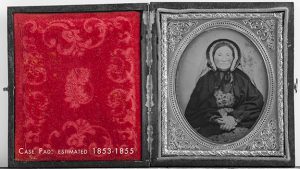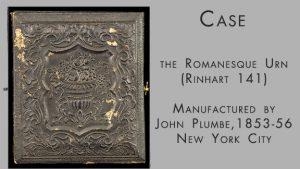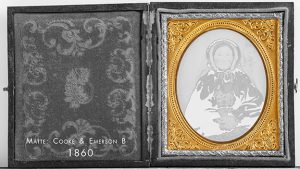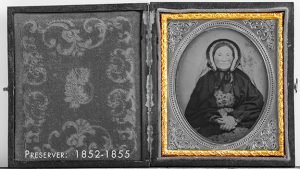How Old is Old?
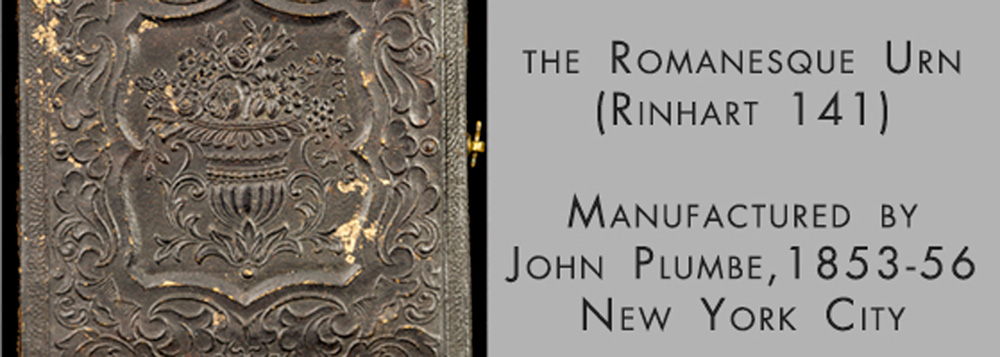
By Dale Wilson, Carriage Room Studio
Great, great, great Grandmother is sternly looking at us through two layers of glass, surrounded in brass and encased in beautiful Moroccan leather. Should this be all that is known, how then does one estimate the date of production?
Such was the case with the ambrotype showcased in our last blog entry. Following the post, that very question was put to me: How can you say that photo is 150 years old?
Dating an old photograph follows a process of elimination, and the first stop at Evergreen is with collections volunteer Karen Colter. Most artefacts that are accessioned to a museum will have a known provenance – the story can be just as important, if not more so, than the piece itself. A known provenance will almost always include sufficient family data and dates to answer initial questions or enable a search of genealogical records to aid in identifying the person in the photo.
Independent of Karen researching the paper trail, Bonnie Elliott, the Museum executive director and noted fashion and textile expert, will be studying the wardrobe of the subject. The fabric pattern, the cut, and style of the material all provide clues to a particular time period with surprising accuracy.
Finally, and again independently of Bonnie and Karen’s work, I study the style of photograph and the materials used in making the photo and case. Much like the fabric, components of the case provide clues and can be of great assistance in dating. These clues are next compared to others in various databases and reference resources.
The first step is to determine the style of photo, a window where we can suggest the photo was made “not before.” For example, we know the Daguerreotype was introduced in 1839, and the wet plate negative (collodion) process in 1851. Therefore, it is easily determined our “subject” was not photographed prior to 1851 as we know it is made via the collodion process. Next, this time-window has to be closed even tighter.
This leads to the case, comprised of four separate identifying and interchangeable features: case, liner, preserver, and matte. There is an infinite number of ways to interchange the components, so we must refer to databases to identify the years in which each of those elements was manufactured.
Gallery – The Identifying Features of an Early Case
By comparing the dates of manufacture, and defaulting to the most recent date it is possible to suggest the case was not assembled prior to 1860. One then assumes the photo was not made prior to the case.
Full disclosure: This calls for speculation as many early photos were set in re-purposed cases, thus the confidence level in accuracy is very reflective of provenance and wardrobe supporting evidence.
At this point consideration must be given to other factors: When did the ambrotype fall out of favour for either the paper print or tintype (mid-1860’s)? When did the leather Moroccan case give way to the Union Case (around 1858, introduced mid-1850’s)? How did the photographer blacken the ambrotype (asphaltum on the film, or second lite of glass), and so on.
Based on the popularity of the components it becomes possible to suggest the photo was made not before 1860, and most likely between 1860 and 1865. The wardrobe, in this case, does not help us to narrow down the dates any further.
The sitter’s wardrobe tells us that she is married evidenced by the gold ring on her left hand. She is wearing a long sleeve day dress that has a full skirt. The print of her gown features dark roses and rose buds that intertwine on stems and leaves that provide a strong contrast over the lighter ground. Over her dress, she wears a cloak or hip length mantle. On her head, her white day-cap with its tightly gathered lace frill sits close to her face. The strands of hair that are shown under her cap are long and straight and parted on her left side. Over her cap is a bonnet that has a skirt near her neck and is caught together by a silk satin bow under her chin. Just visible is a veil made of netting that is draped over her bonnet and falls over her shoulders. Her cap and bonnet hark to the 1850’s and are by now dated.
The question remains: Who can identify this ambrotype of their great, great, great (and maybe another great, or two) Grandmother that was taken between 1860 and 1865?


